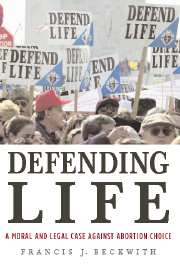Book contents
- Frontmatter
- Contents
- Acknowledgments
- Introduction
- PART I MORAL REASONING, LAW, AND POLITICS
- PART II ASSESSING THE CASE FOR ABORTION CHOICE AND AGAINST HUMAN INCLUSIVENESS
- 4 Science, the Unborn, and Abortion Methods
- 5 Popular Arguments
- 6 The Nature of Humanness and Whether the Unborn Is a Moral Subject
- 7 Does It Really Matter Whether the Unborn Is a Moral Subject? The Case from Bodily Rights
- PART III EXTENDING AND CONCLUDING THE ARGUMENT
- Notes
- Selected Bibliography
- Index
4 - Science, the Unborn, and Abortion Methods
from PART II - ASSESSING THE CASE FOR ABORTION CHOICE AND AGAINST HUMAN INCLUSIVENESS
Published online by Cambridge University Press: 05 June 2012
- Frontmatter
- Contents
- Acknowledgments
- Introduction
- PART I MORAL REASONING, LAW, AND POLITICS
- PART II ASSESSING THE CASE FOR ABORTION CHOICE AND AGAINST HUMAN INCLUSIVENESS
- 4 Science, the Unborn, and Abortion Methods
- 5 Popular Arguments
- 6 The Nature of Humanness and Whether the Unborn Is a Moral Subject
- 7 Does It Really Matter Whether the Unborn Is a Moral Subject? The Case from Bodily Rights
- PART III EXTENDING AND CONCLUDING THE ARGUMENT
- Notes
- Selected Bibliography
- Index
Summary
What does it mean to say that a particular being is human, that he or she is a member of the species Homo sapiens? How, for example, may one distinguish a human being from, let's say, a dog, a cat, a grapefruit, or a human being's part such as a finger or a blood cell? And if the being in the womb is a human being, what are the methods by which the abortionist accomplishes his goal of extinguishing that being's life? In this chapter we will answer these questions. We will do so by presenting the facts of prenatal development as well as the methods used by physicians to terminate an unwanted pregnancy. Given the gravity of a woman's choice to abort – as all parties in this dispute concede – we have an obligation to become conversant with these matters, troubling though they are.
It surprises many people when they are told that most sophisticated defenders of abortion choice concede that the unborn, long before birth, is a human being, though they argue that it lacks a property essential to acquiring the status of a moral person. And thus, a pregnant woman may kill that entity prior to its acquisition of that property. Although an important subject – one that is addressed in great detail in Chapter 6 – in this chapter we take up the more modest task of simply showing that the unborn is a human being from conception as well as presenting the methods by which it may be killed in an abortion.
- Type
- Chapter
- Information
- Defending LifeA Moral and Legal Case against Abortion Choice, pp. 65 - 92Publisher: Cambridge University PressPrint publication year: 2007



